9 Best UserTesting Alternatives for UX Research
You already know how important UX research is. What you’re trying to figure out now is what to use instead of UserTesting.
Maybe it’s the lack of transparent pricing. Maybe the panel quality hasn’t been cutting it. Maybe you’re just tired of needing a sales call to get a quote. Whatever the reason, a growing number of teams are moving away from UserTesting — and not just startups looking to save. Even enterprise-level research professionals are looking for UserTesting alternatives that better match their workflow, budgets, and need for deeper insights.

Source: Unsplash
This article is for you. We’ve reviewed 10 solid alternatives — each with their own strengths, quirks, and ideal use cases. Whether you’re looking for better analysis tools, simpler test setups, or more flexible participant sourcing, we’ll help you sort through the options.
Let’s compare what’s actually out there in 2025.
Why teams are switching from UserTesting
Even when they’ve been using UserTesting for years, more and more teams are starting to look elsewhere. Here are the main reasons why folks are switching to different UserTesting alternatives:
1. Opaque pricing
First of all, UserTesting doesn’t list prices publicly — you have to talk to sales just to get a ballpark. That’s frustrating when you’re trying to plan ahead or get stakeholder approval. With enterprise plans at record high prices, most teams find it hard to justify the spend. In other words, it’s no longer cost-effective.
2. Outgrown features and lack of flexibility
As workflows evolve, UserTesting can start to feel rigid. The seat‑plus‑credits model doesn’t give much room to move, and the platform isn’t built for custom panels or lightweight iteration. Once your team’s research needs grow beyond the basics, those limits show fast.
3. Panel quality doesn’t always deliver
Many teams report that participant responses on UserTesting feel rushed, vague, or low-effort, likely because incentives aren’t always aligned. The participant panel is large, but volume doesn’t equal quality. For researchers who need niche users or high-quality insights, that’s a dealbreaker.
Other tools like PlaybookUX offer more refined panel filters — based on industry, demographics, and geography, making it easier to find participants who actually match your use case.
4. Missing features for remote, async teams
For remote teams or those working in agile design cycles, UserTesting can fall short. There’s no built-in support for diary studies, limited async-friendly workflows, and fewer integrations with communication tools like Slack or design tools like Figma.
When you need to collect in-context insights over time, not just one-off sessions, you want advanced features to support team members across the globe.
5. Not a great fit for teams democratizing research
UserTesting’s pricing model can feel like a mismatch. Hidden fees, unclear billing, and required seat minimums don’t leave much flexibility for teams who want to democratize research.
That’s why teams are exploring alternatives that feel more aligned with how they actually work — and what they can realistically budget.
The top 10 UserTesting alternatives in 2025
There’s no shortage of UX research tools out there, but not all of them can truly replace UserTesting.
Some are better suited for moderated user interviews. Others shine when it comes to unmoderated testing, diary studies, or early-stage design validation. A few go deep on analysis and reporting, while others prioritize speed and simplicity.

Source: Unsplash
Below, we break down 10 of the most reliable UserTesting alternatives available in 2025. For each tool, we’ll cover what it does best, where it may fall short, and who it’s actually built for — so you can decide what fits your workflow, timeline, and budget.
PlaybookUX
PlaybookUX is a flexible, full-featured user research platform built to support both moderated and unmoderated user research. It covers the full spectrum of testing methods — remote video interviews, task-based usability studies, card sorting and tree testing, as well as surveys. You can either recruit from the global panel of vetted participants or bring your own users, with detailed screening options available in both cases. PlaybookUX also offers AI-powered tools to tag user insights, auto-generate themes, and help you synthesize findings faster.
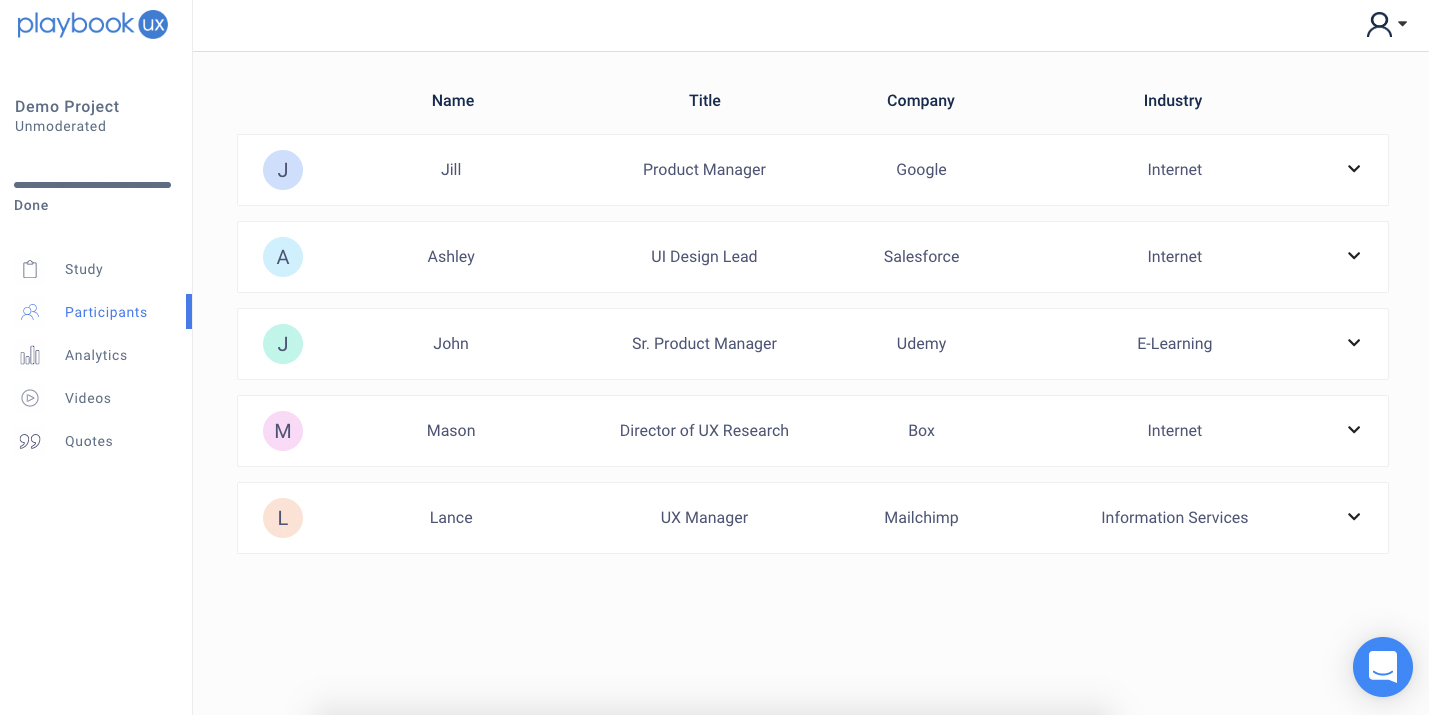
Source: PlaybookUX
What sets PlaybookUX apart as an alternative to UserTesting is that it doesn’t force you into a one-size-fits-all workflow. Whether you’re running early concept validation or later-stage usability tests, it adapts well to different research rhythms and team sizes.
Key strengths
- Supports all methodologies – unmoderated, moderated, card sort, tree test, surveys, first click, five second, preference test and more.
- Unlike all other tools in the market, PlaybookUX offers Session Replays & Intercepts
- Built-in global panel with detailed screeners — or bring your own participants option
- Integrate directly with Figma for access to goal-based analytics and interactive heat map overlays that inform design decisions.
- Repository features such as tagging and universal search.
- AI-powered analysis for real-time insights and easier reporting
- Remote-first and async-friendly design
What you might miss
- No in-person testing options
Pricing
PlaybookUX offers four pricing models tailored to fit the usability testing needs of your team. There are four tiers available:
- Pay as you go – Moderated and unmoderated usability testing with extra perks available without an annual subscription
- Scale – Card sorting, tree testing, participant recruitment, and more for $5,400 billed annually
- Pro – Everything in Scale, plus approval flow for usability testing, custom consent forms, invisible observers, and SSO + SAML for $8,800 per year
- Custom – For enterprises, there is a custom pricing model available, tailored for the complex user testing needs of your company.
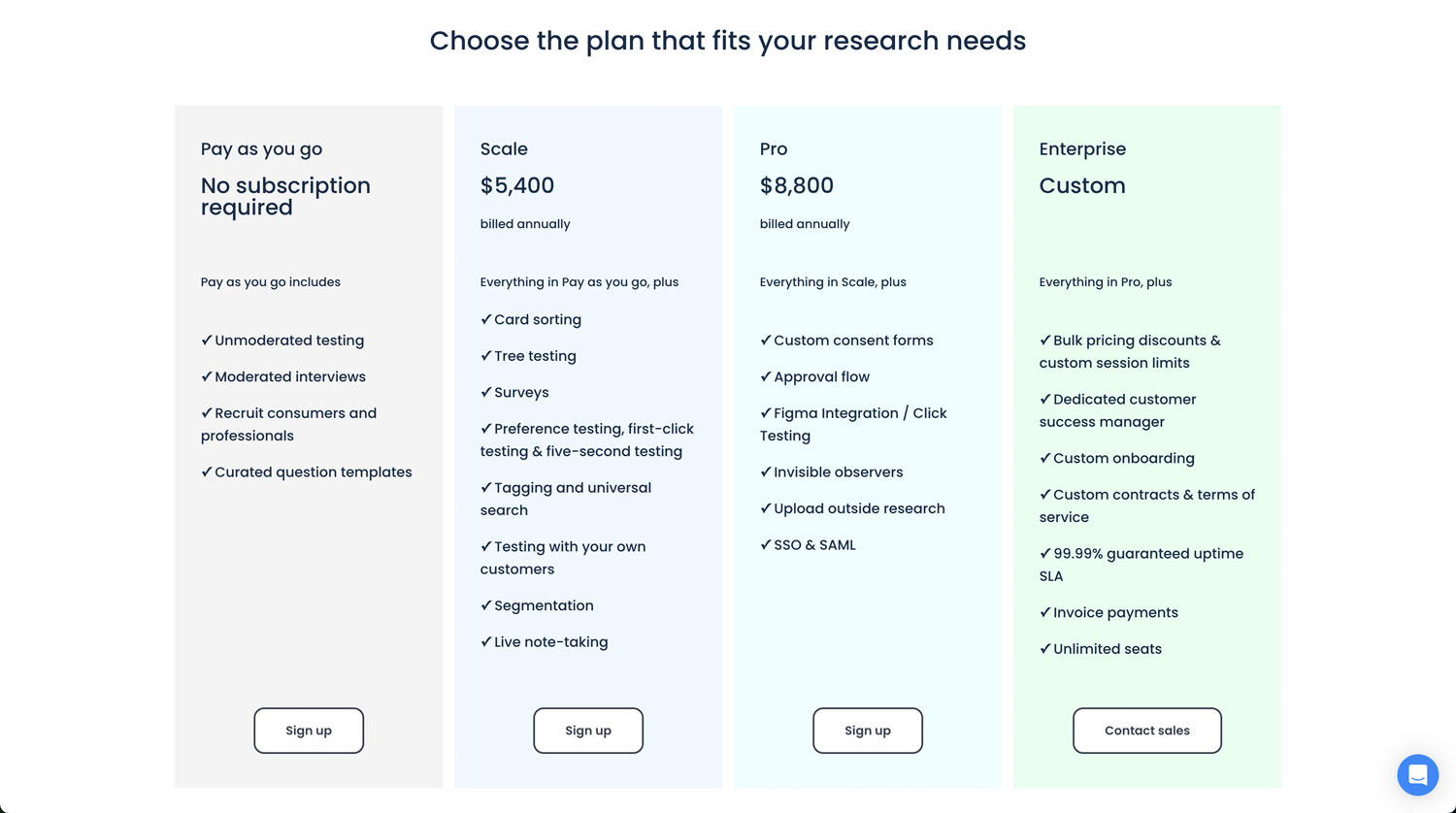
Source: PlaybookUX
While the Pay as you go model has an annual limit of 50 sessions, with other plans you can enjoy custom pricing with all features included.
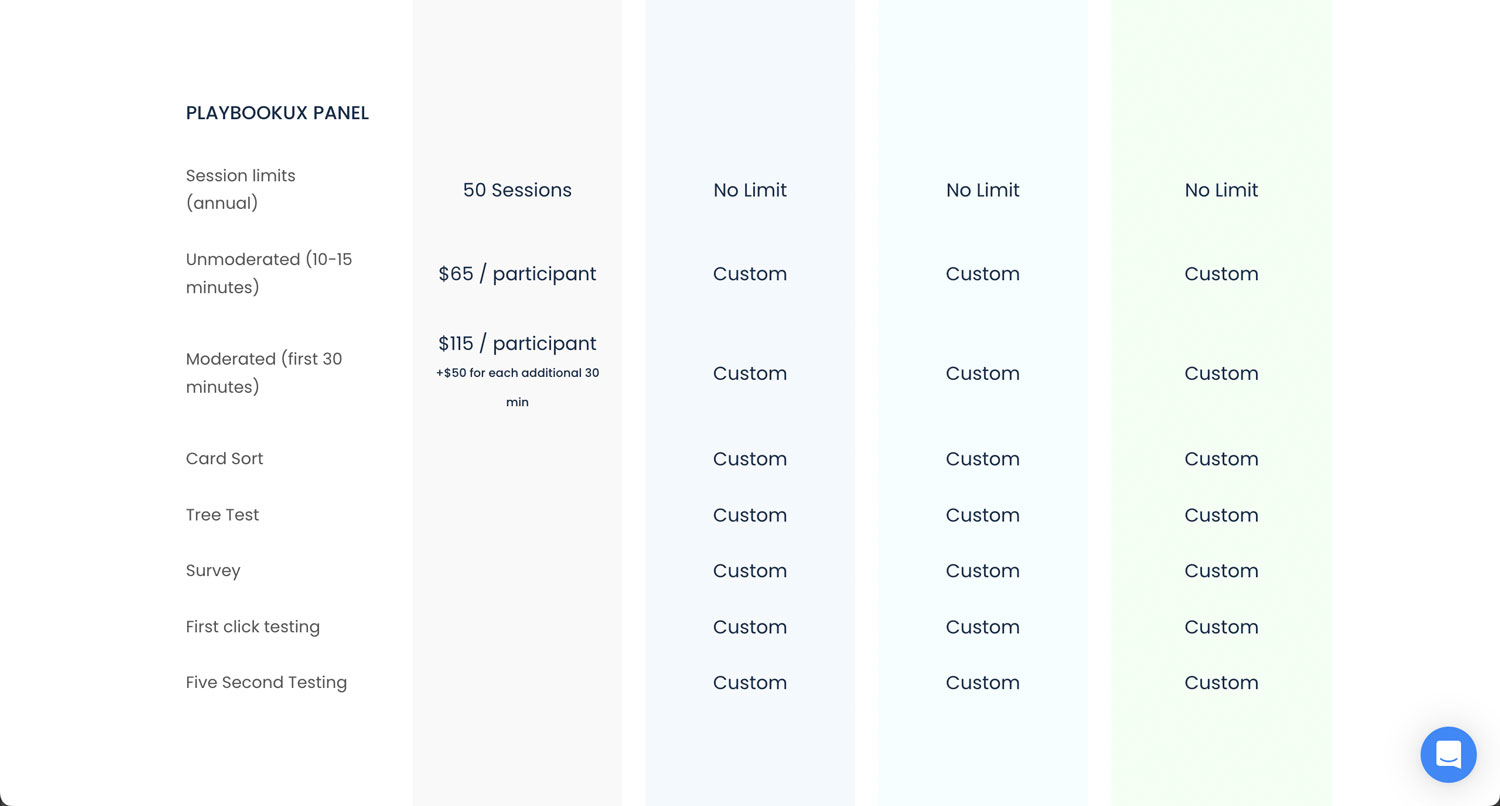
Source: PlaybookUX
We’d recommend it to
Mid-sized and enterprise teams running continuous user research across multiple product lines or departments. PlaybookUX is ideal for organizations that need comprehensive qualitative and quantitative research management, robust repository capabilities without restrictions, and full control over participant recruitment and research governance requirements. It’s a strong fit for research operations that require advanced analysis tools, flexible study formats, and enterprise-level support.
dScout
dScout is best known for its capabilities in longitudinal and diary-style research, making it a strong choice for teams studying user behavior over time. It allows participants to submit entries via mobile, in real time, in real-world settings as they go about their daily lives — ideal for capturing in-context insights and routines. The platform also supports moderated and unmoderated studies, though its focus is on mobile app testing and qualitative depth.
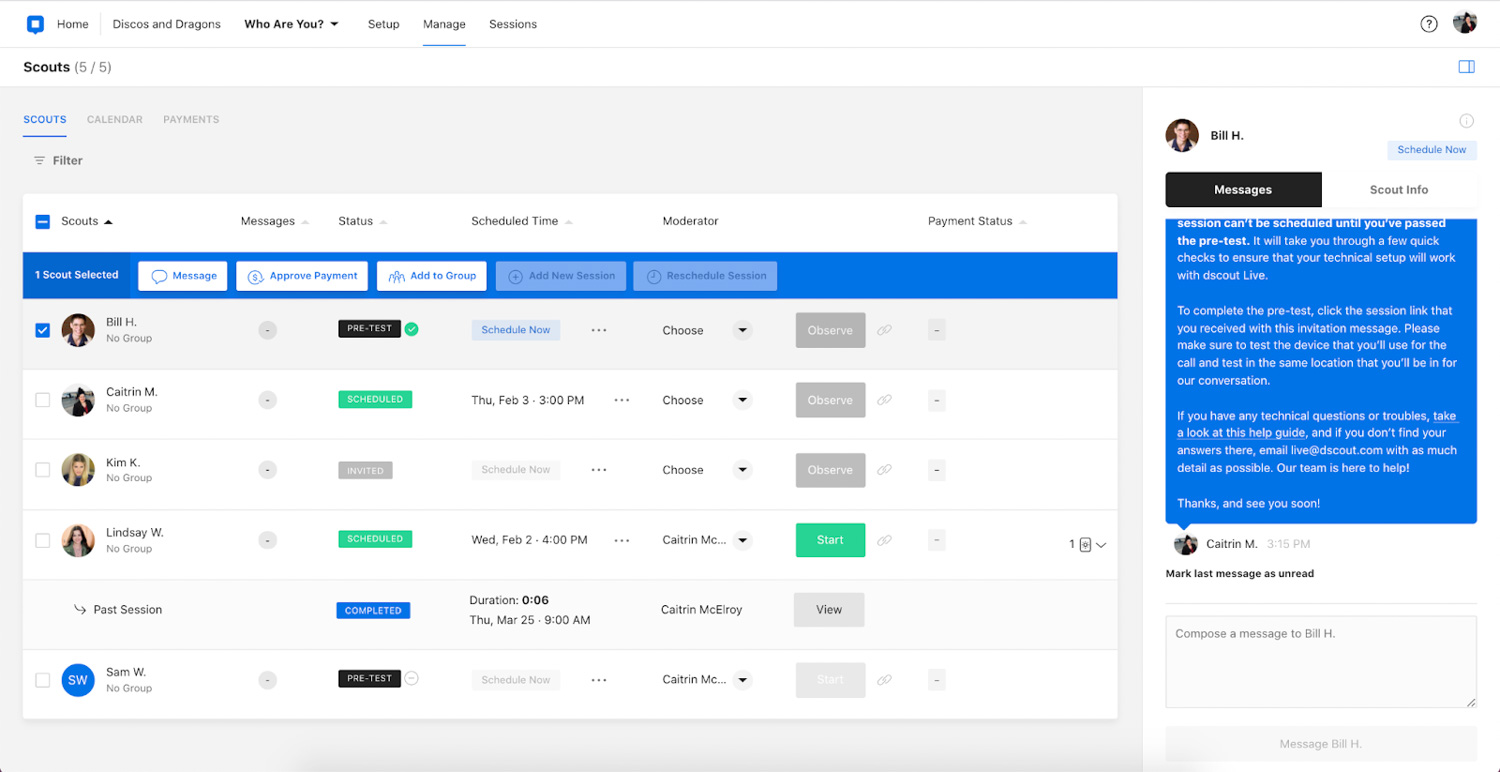
Source: dScout
Key strengths
- Designed for diary studies and longitudinal research
- Captures real-time, in-context responses through a mobile app for remote usability testing
- Supports video, photo, and text inputs for richer qualitative data
- Includes analysis tools for tagging, filtering, and summarizing entries
What you might miss
- Not ideal for quick, task-based usability testing
- Steeper learning curve compared to simpler tools
- Participant recruitment is managed by dScout, with less control over screening
- Pricing is not transparent and may be high for smaller teams
Pricing
dScout does not publicly list pricing. Plans are customized based on your needs, and pricing is generally tailored to larger research operations.
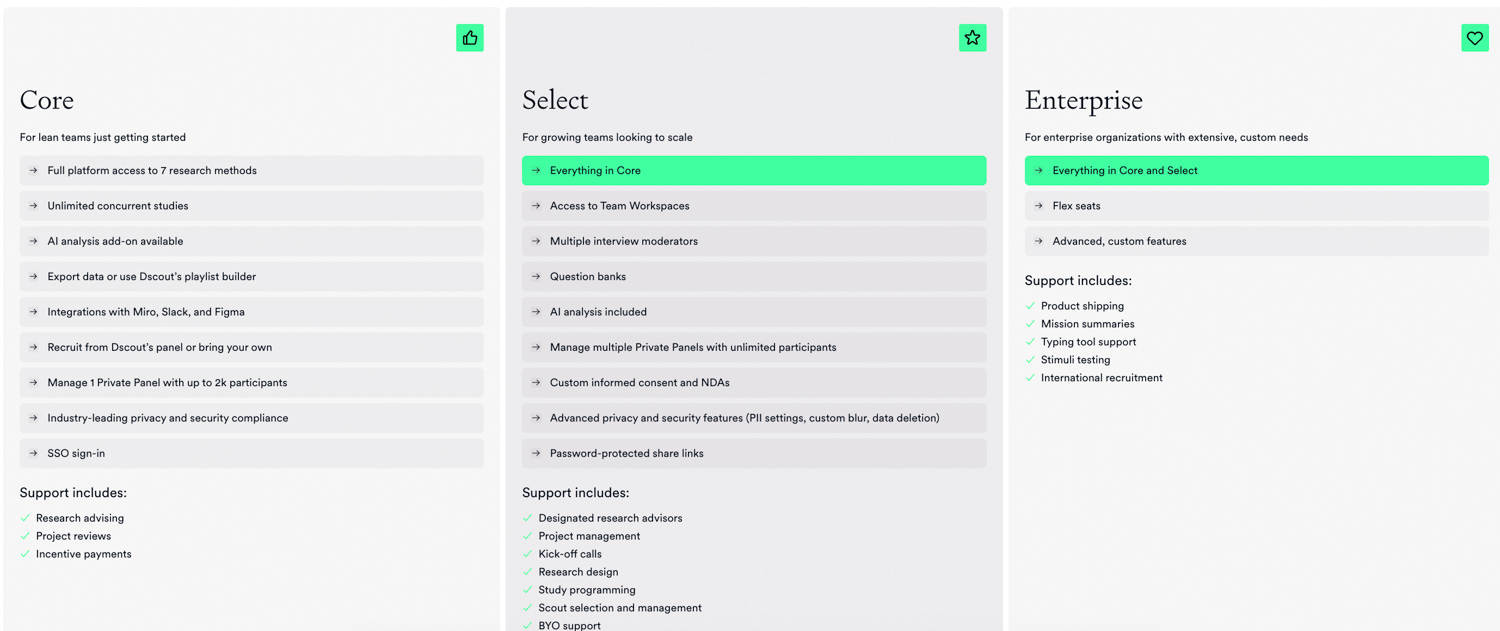
Source: dScout
We’d recommend it to
Larger teams or research units focused on deep qualitative insights, especially when studying behaviors over time. dScout is a fit for companies running longitudinal product research, in-context studies, or brand experience tracking, particularly when mobile engagement is a key part of the research design.
Userlytics
Userlytics is a remote user testing platform that supports both moderated and unmoderated studies across desktop and mobile devices. It stands out for its advanced test logic, which allows researchers to build more complex study flows with branching paths, conditional tasks, and customized sequences. The platform supports a variety of methods, including usability testing, card sorting, tree testing, surveys, and prototype testing.

Source: Userlytics
Key strengths
- Flexible setup with advanced branching logic
- Supports multiple test types and device compatibility
- Access to a large, international participant panel (nearly 2 million testers across over 150 countries)
- Video playback, session metrics, and UX scoring features included
What you might miss
- Dashboard UI can feel dated or unintuitive
- A credit-based pricing model may be confusing at first
- Limited third-party integrations
- Some users report slower video processing for larger studies
Pricing
Userlytics’ pricing model depends on several parameters: whether you are using their existing panel for user feedback or recruiting yourself, whether you want project-based or long-term subscription commitment, and lastly, how many accounts and sessions you’ll need per year. To get a specific offer for your team, though, you’ll need to speak with their sales rep.
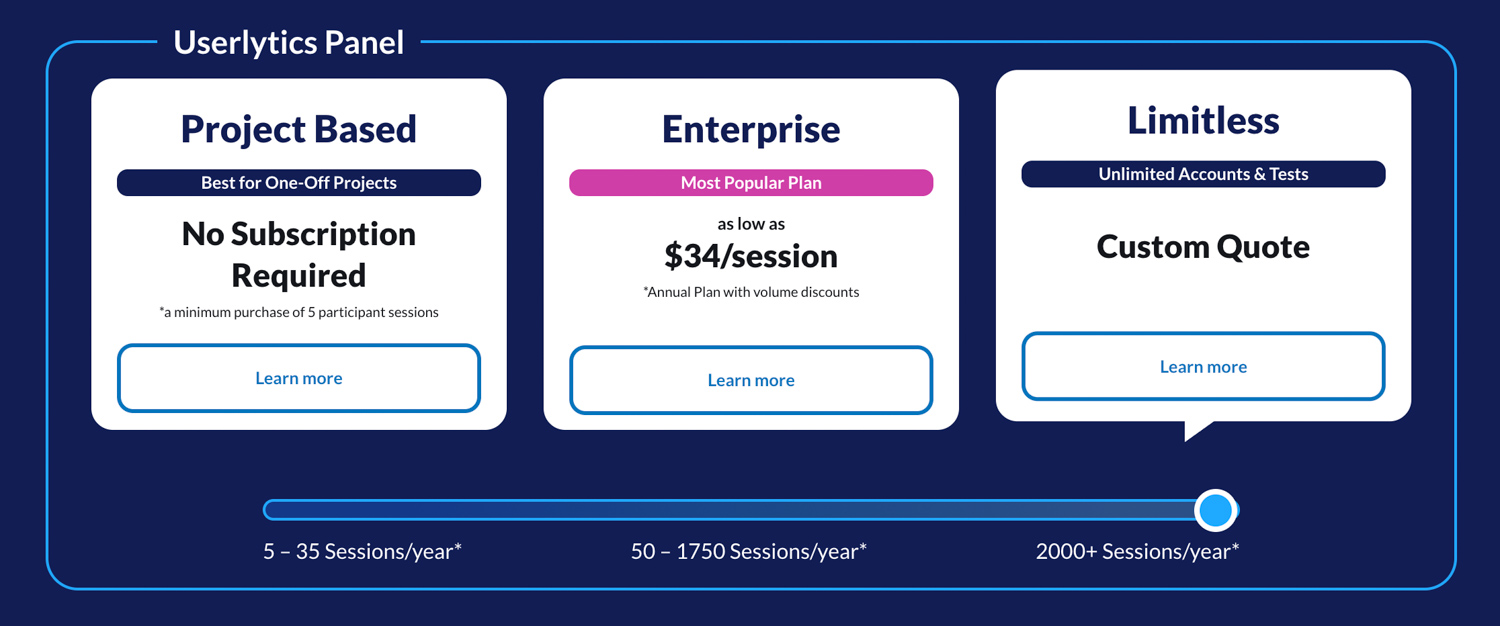
Source: Userlytics
We’d recommend it to
UX teams and researchers who need to build custom study flows, particularly when testing across multiple devices or running a mix of research methods. Userlytics is best suited for organizations that value logic-based test design and need access to a broad international panel.
UserZoom
UserZoom is an enterprise-grade user research platform designed for large organizations running continuous, high-volume studies. It supports a wide range of methods — including task-based usability tests, surveys, benchmarking, and remote interviews — and offers extensive integrations with tools like Jira, Slack, and analytics platforms. Known for its depth, UserZoom has long been favored by teams with established research operations.
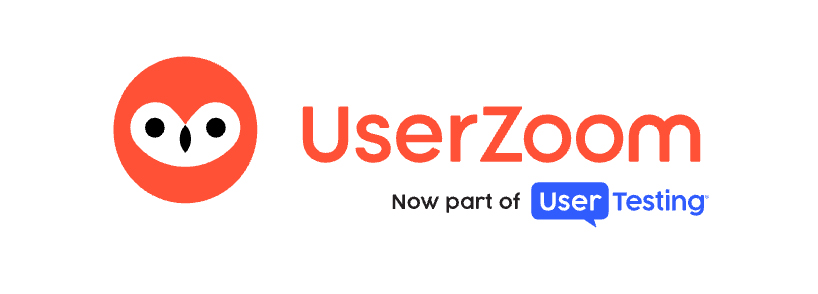
However, in 2023, UserZoom was acquired by UserTesting. In 2024, UserTesting announced that the UserZoom platform would be sunset, with the phase-out now underway. Some teams have already been asked to migrate, while others are still using the platform temporarily. As a result, many are now actively seeking replacements with similar enterprise capabilities.
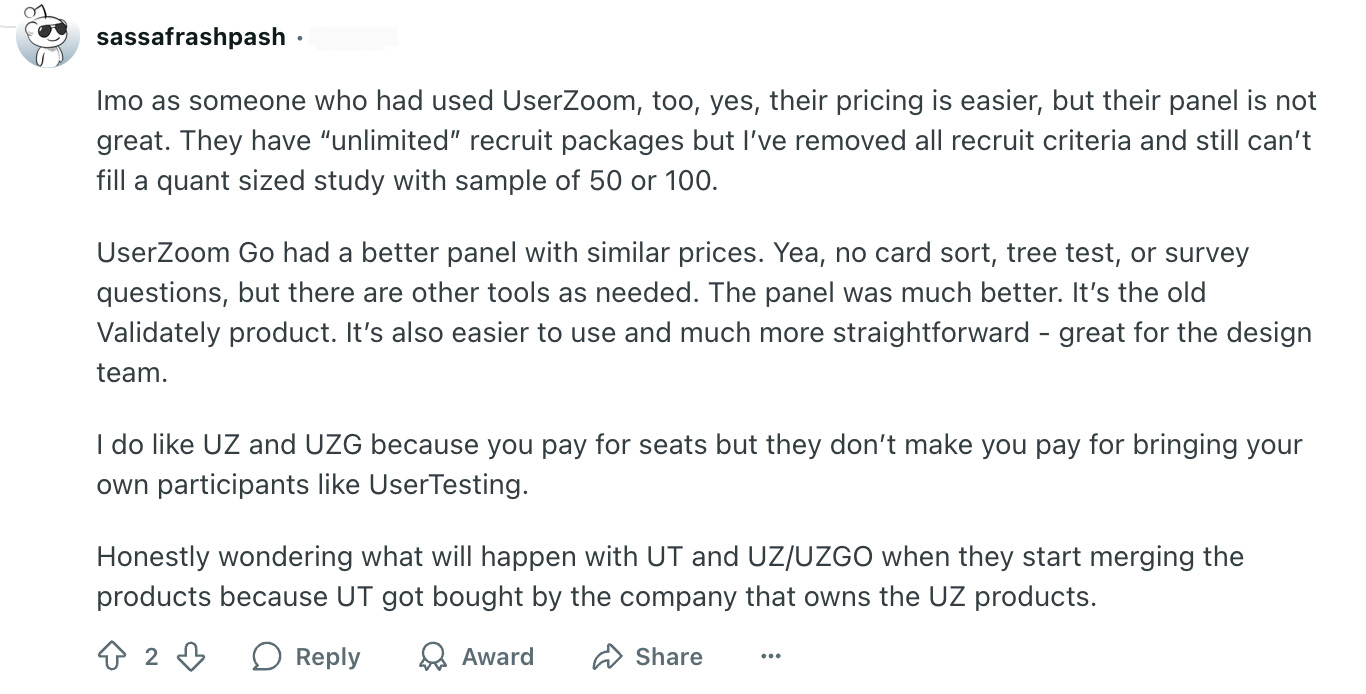
Source: Reddit
Key strengths
- Built for enterprise research teams with multiple stakeholders
- Supports benchmarking and comparative testing
- Broad integrations with other analytics and PM tools
- Scalable for high-volume, cross-team use
What you might miss
- Steep learning curve, especially for newer users
- Complex setup for smaller teams or one-off studies
- Platform is being sunset — future use is time-limited
Pricing
As of the acquisition, the pricing of UserZoom is, in fact, the pricing of UserTesting; thus, looking for UserTesting alternatives comes down to searching for UserZoom alternatives.
We’d recommend it to
Currently, only legacy users who are still operating under a UserZoom contract. If you’re one of them, it’s worth exploring replacement tools now—especially those that support large teams, integrations, and structured research workflows. This guide offers several strong alternatives to consider.
Maze
Maze is a usability testing platform built for design-stage validation. It integrates directly with design tools like Figma, Adobe XD, and Sketch, allowing prototype testing before writing any code. Maze supports unmoderated usability testing, preference tests, surveys, and five-second tests, making it well-suited for early user feedback during the design process.
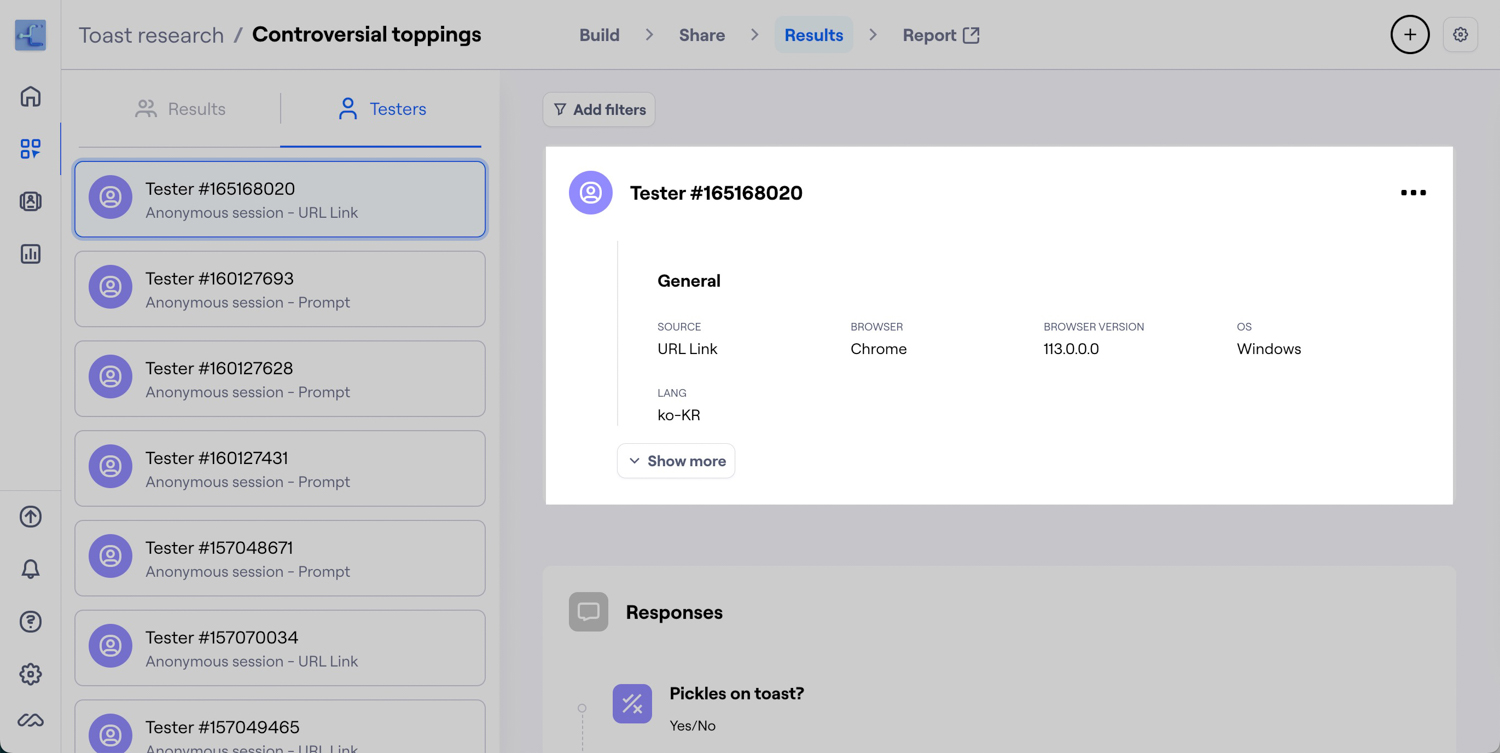
Key strengths
- Figma and design tool integrations
- Good for async, early-stage team collaboration
What you might miss
- Limited qualitative depth
- Not designed for longitudinal or contextual studies
Pricing
Maze offers three pricing tiers:
- Free plan: Limited features and participant counts
- Starter: $99/month (billed annually)
- Organization: Custom pricing with advanced support and collaboration features
Participant recruitment is a separate cost via third-party services or your own sources.
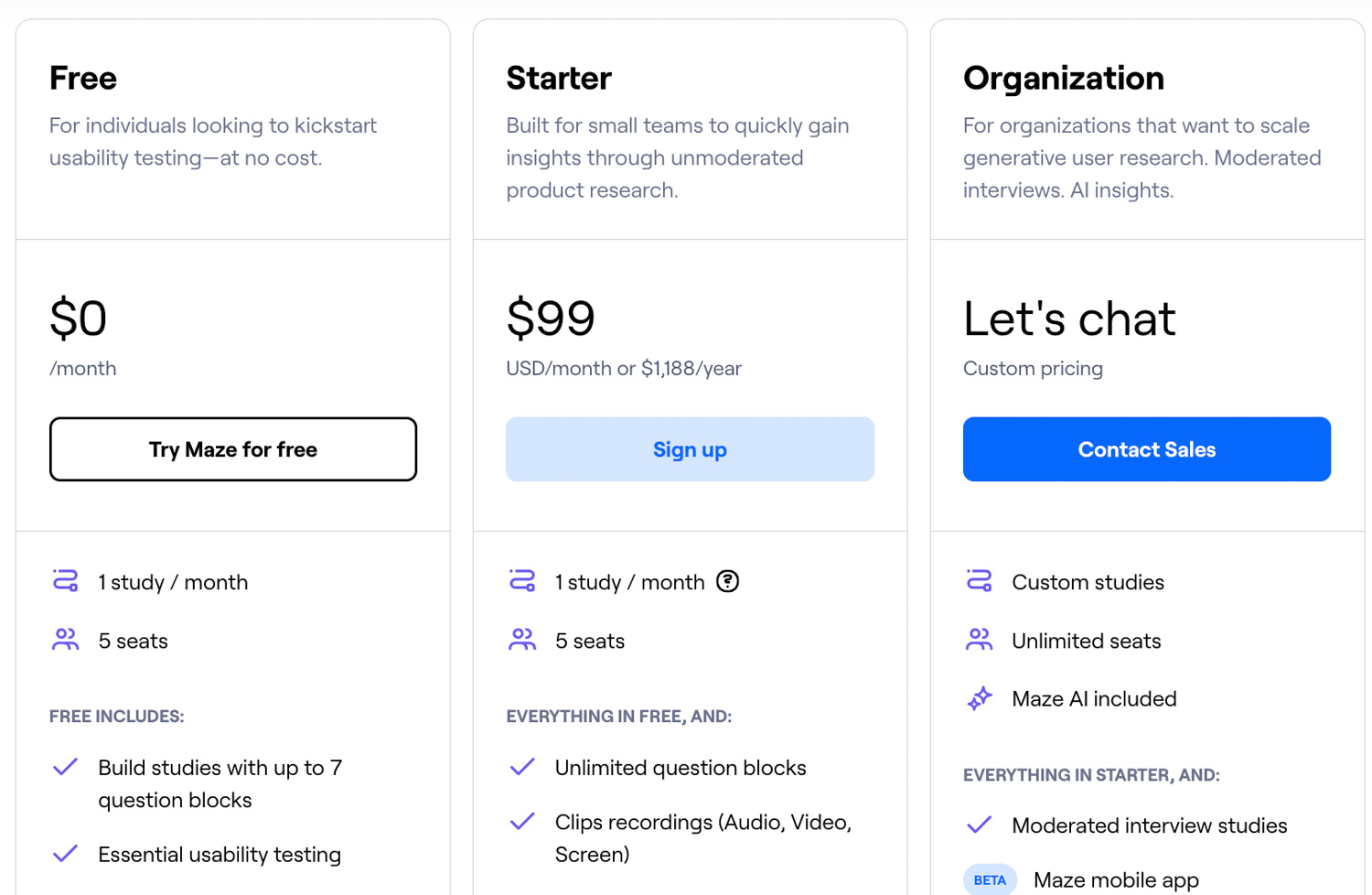
Source: Maze
We’d recommend it to
Design and product teams that need to validate prototypes quickly, especially during iterative sprints. If you need an alternative to UserTesting that goes beyond prototype testing, then look for Maze alternatives.
UXtweak
UXtweak is an all-in-one user research platform designed for structured UX testing across websites, prototypes, apps, and digital products. It supports a wide range of research methods, including usability testing, tree testing, card sorting, surveys, session recording, and prototype testing.

Source: UXtweak
Key strengths
- Includes session recording and analytics
- Clean, modern UI with easy test setup
- 1 user license pricing model
What you might miss
- Some users report minor UI bugs or lag in larger studies
- Lacks enterprise features that you may be used to
Pricing
UXtweak offers:
- Free plan: For up to 15 responses per month
- Business: $143/month
- Custom: Tailored pricing with additional support and security
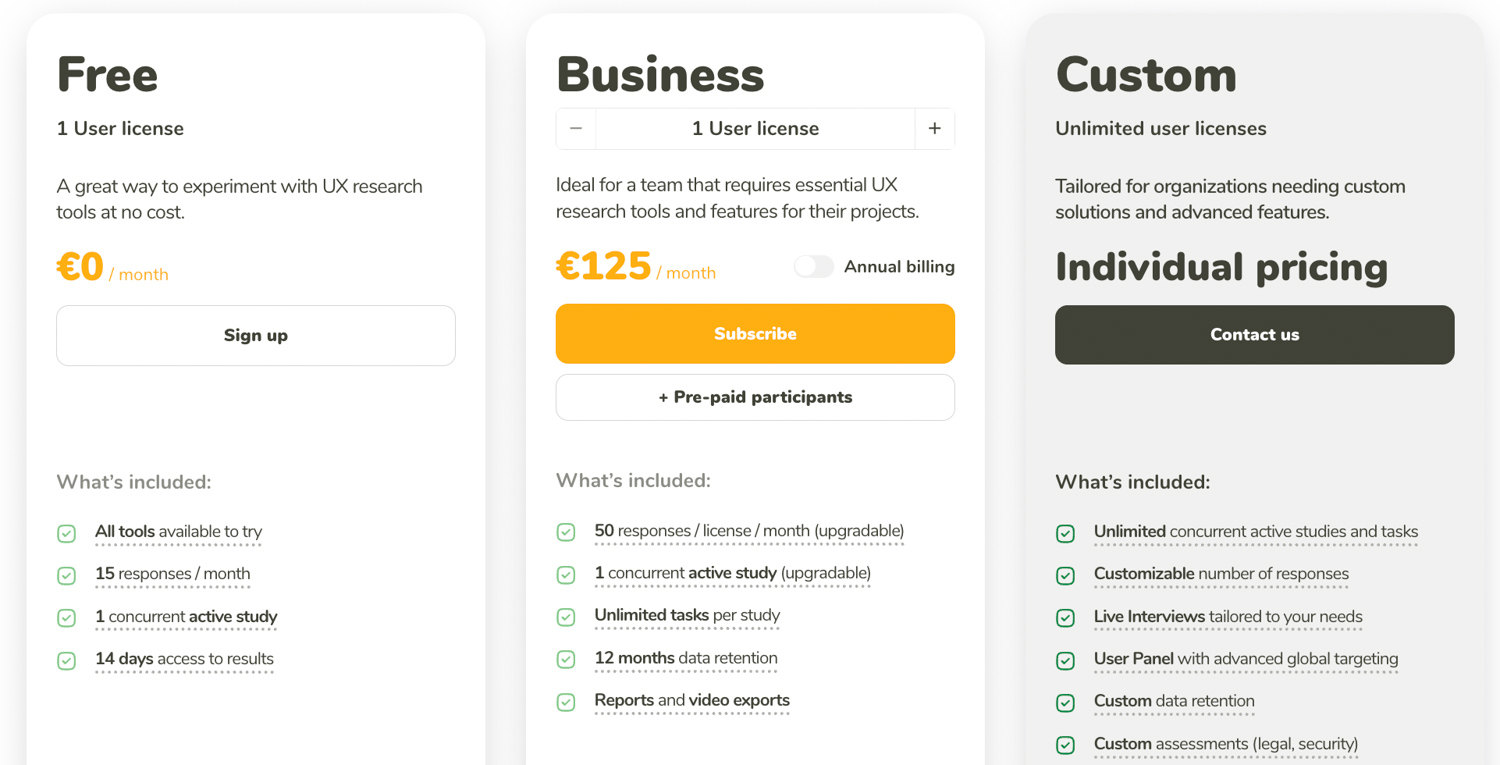
Source: UXtweak
We’d recommend it to
Teams looking for a budget-friendly, full-featured UX testing platform. UXtweak is a strong option for those who value test variety and analytics but don’t need advanced enterprise workflows.
Trymata (TryMyUI)
Trymata — formerly known as TryMyUI — is a longstanding usability testing alternative to UserTesting focused on helping teams capture video-based user feedback on websites and prototypes. It offers both moderated and unmoderated testing, with core features like session recordings, task-based tests, post-test surveys, and UX scoring.
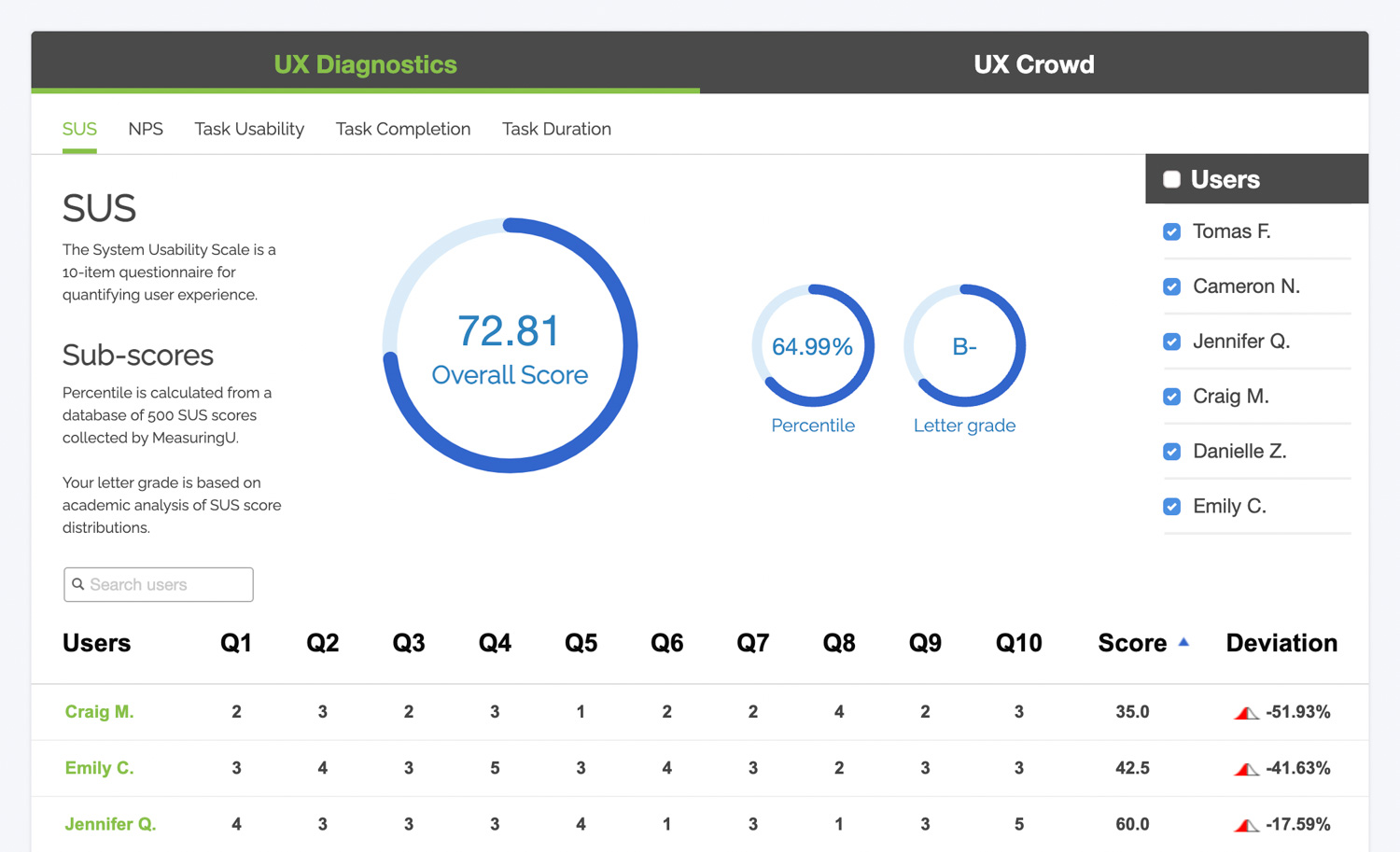
Source: Trymata
Key strengths
- Simple interface and fast test setup
- Supports both moderated and unmoderated studies
- Built-in UX diagnostics and session recordings
What you might miss
- Limited integrations with third-party tools
- Reporting and analysis tools are relatively basic
- The participant panel may lack depth for niche targeting
- Not ideal for complex, multi-team research environments
Pricing
Trymata offers four plans:
- Team: $399/month (basic testing tools)
- Enterprise: $1,667/month (adds team features and analytics)
- Unlimited: $3,333/month for a deeper understanding of user behavior analytics
- Agency: Custom pricing for large-scale qualitative and quantitative testing

Source: Trymata
We’d recommend it to
Agencies that work with a large pool of small and medium-sized organization clients.
Lyssna (formerly UsabilityHub)
Lyssna is a lightweight user research tool focused on quick feedback methods like preference testing, first-click tests, five-second tests, and surveys. It’s designed for speed and simplicity — ideal for validating early design choices or copy variations without heavy setup. The platform also includes a panel of over 690k participants, filterable by demographic and behavioral attributes.
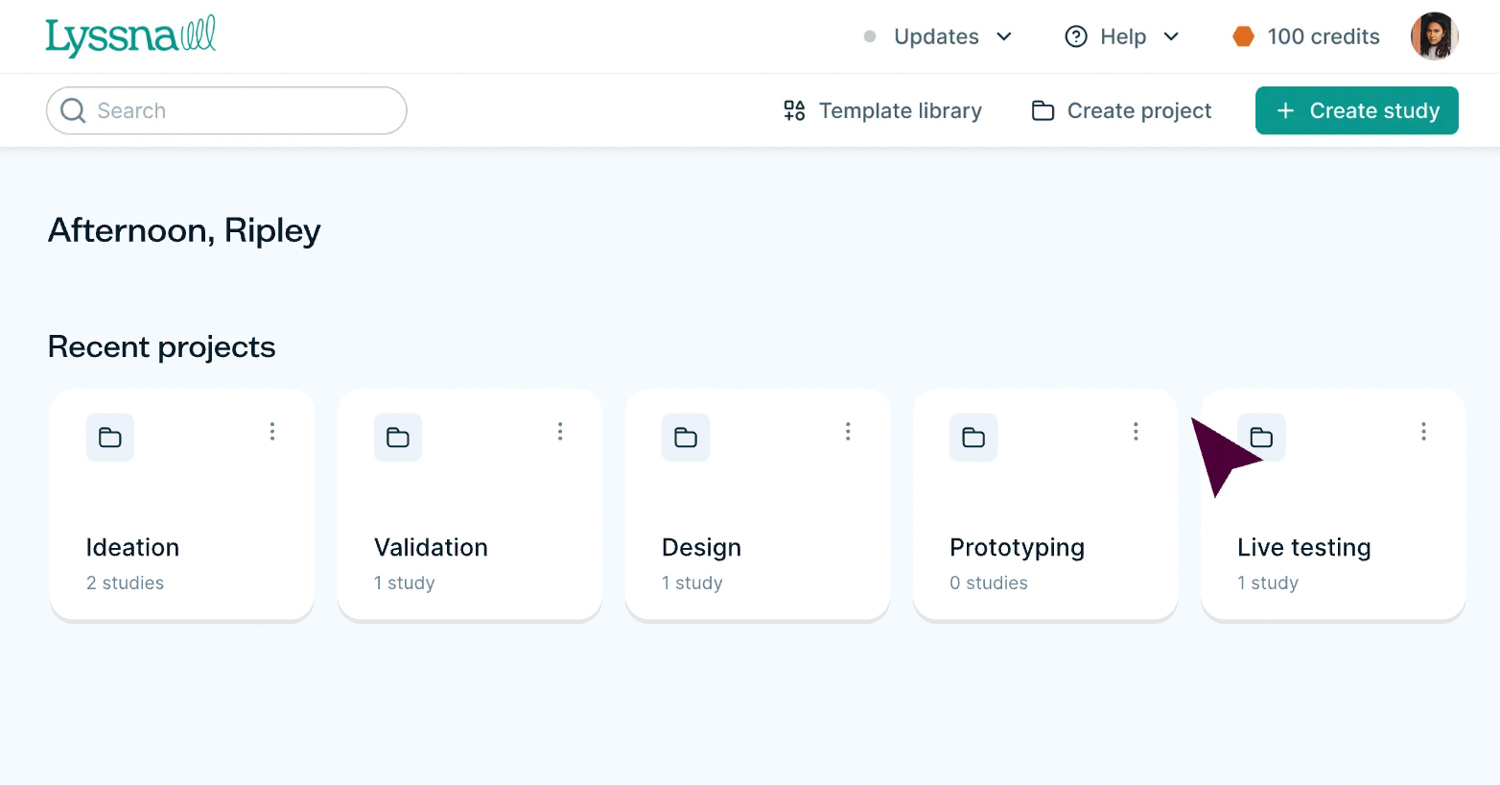
Source: Lyssna
Key strengths
- Fast test creation and easy to use
- Supports preference tests, first-click tests, five-second tests, and surveys
- Access to a diverse panel
- Good for early-stage feedback and design iteration
What you might miss
- No support for moderated testing or usability sessions
- Doesn’t offer full task-based workflows or session videos
- Limited tools for in-depth qualitative analysis
- Less suited for iterative or longitudinal research
Pricing
Lyssna offers four pricing tiers:
- Free: Basic test types, bring your own participants
- Basic: $89/month
- Pro: $199/month
- Enterprise: Custom pricing with team management and advanced security
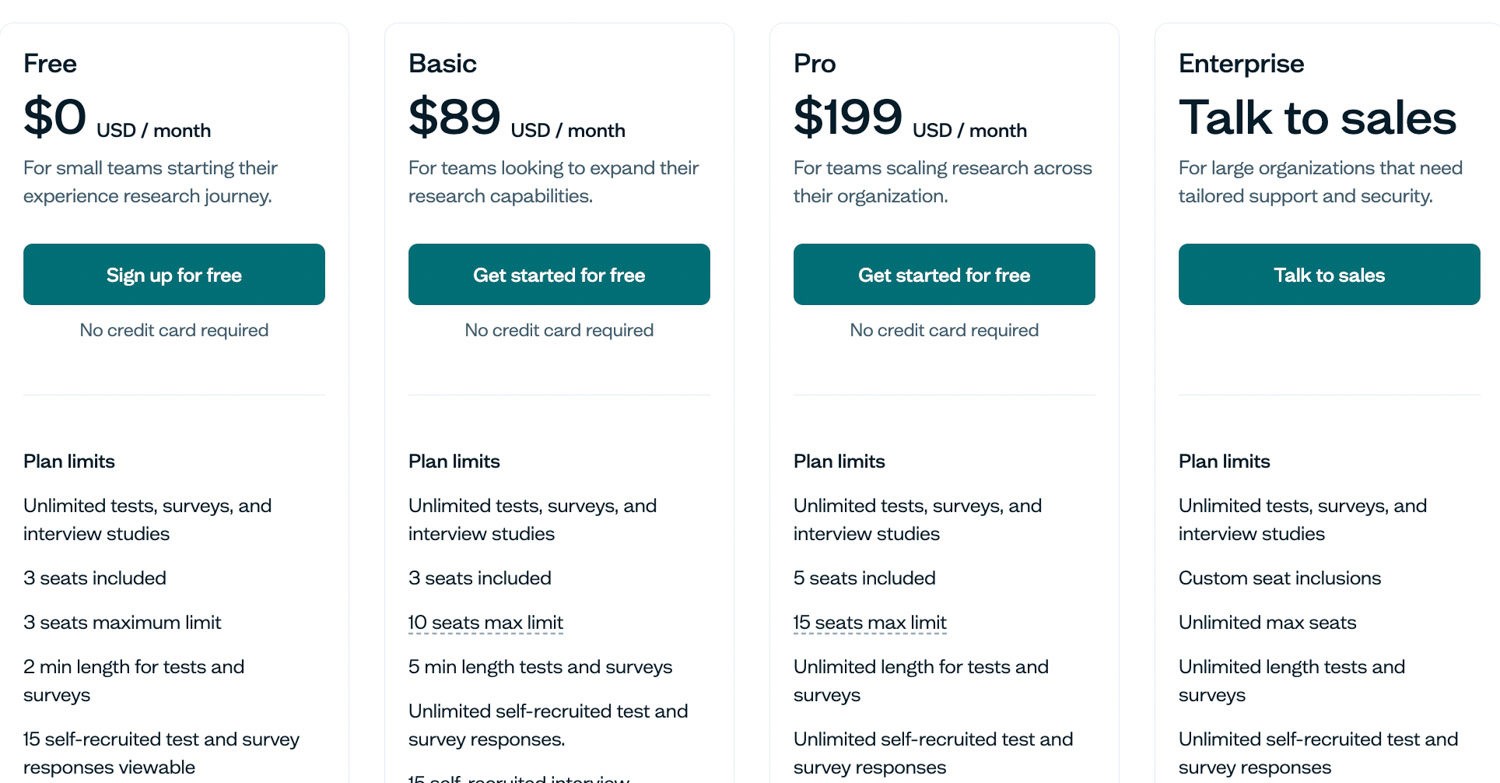
Source: Lyssna
We’d recommend it to
Small teams with general demographics who want feedback on design decisions, marketing content, or UI layouts. Lyssna is best used for simple validation tasks, not full-scale usability research.
Loop11
Loop11 is one of the original remote usability testing platforms, known for supporting task-based studies on live websites, prototypes, and apps. It offers quantitative and qualitative data through heatmaps, clickstream analysis, success metrics, and detailed participant paths, making it a go-to for structured usability evaluations. Unlike many newer tools, Loop11 is optimized for testing fully functional products, not just early designs.
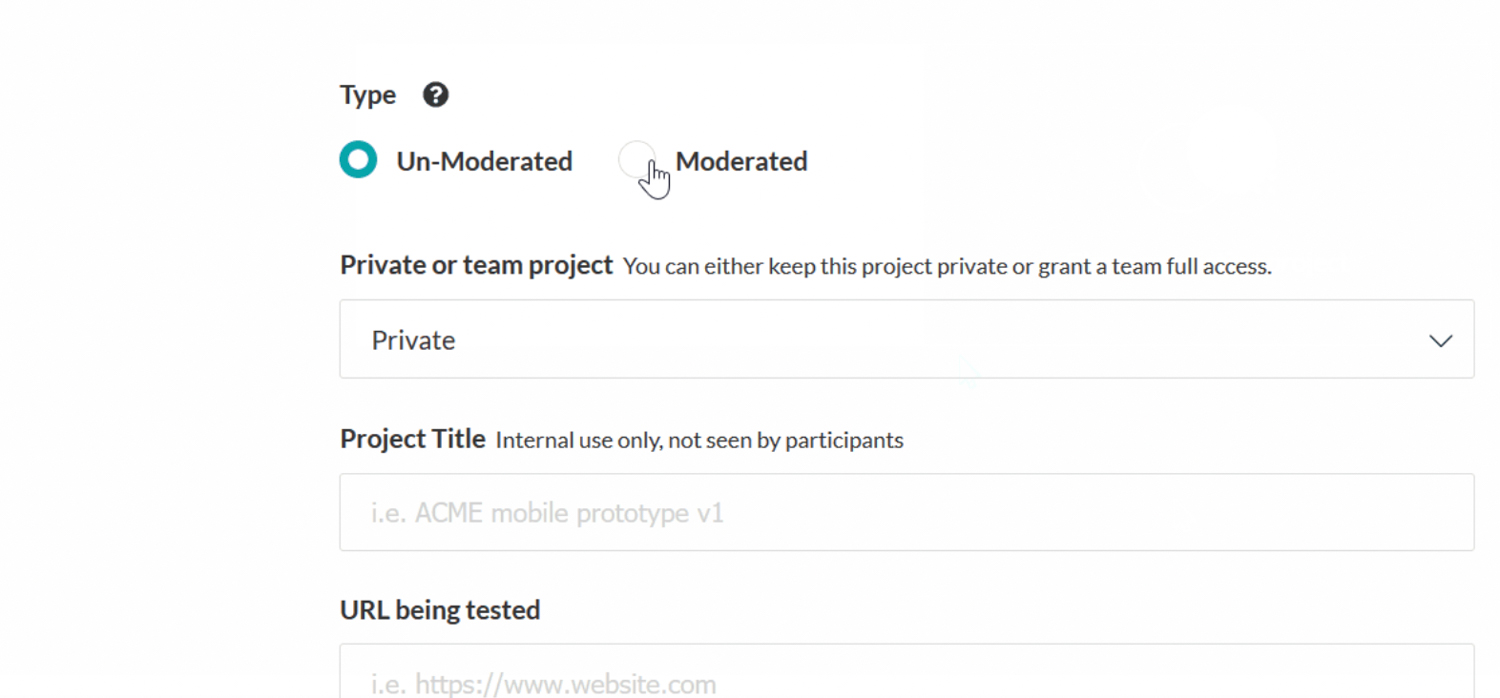
Source: Loop11
Key strengths
- Handles live website and prototype testing
- Offers quantitative data like task success, time on task, and click paths
- Compatible with desktop and mobile environments
- No-code test setup and multilingual support
What you might miss
- Outdated interface compared to more modern platforms
- Lacks built-in participant panel — BYO or integrate externally
- Limited integrations with design tools
Pricing
Loop11 offers:
- Rapid Insights – $199/month
- Pro – $399/month (adds features like session replay and advanced reporting)
- Enterprise – Custom pricing with additional support and user seats
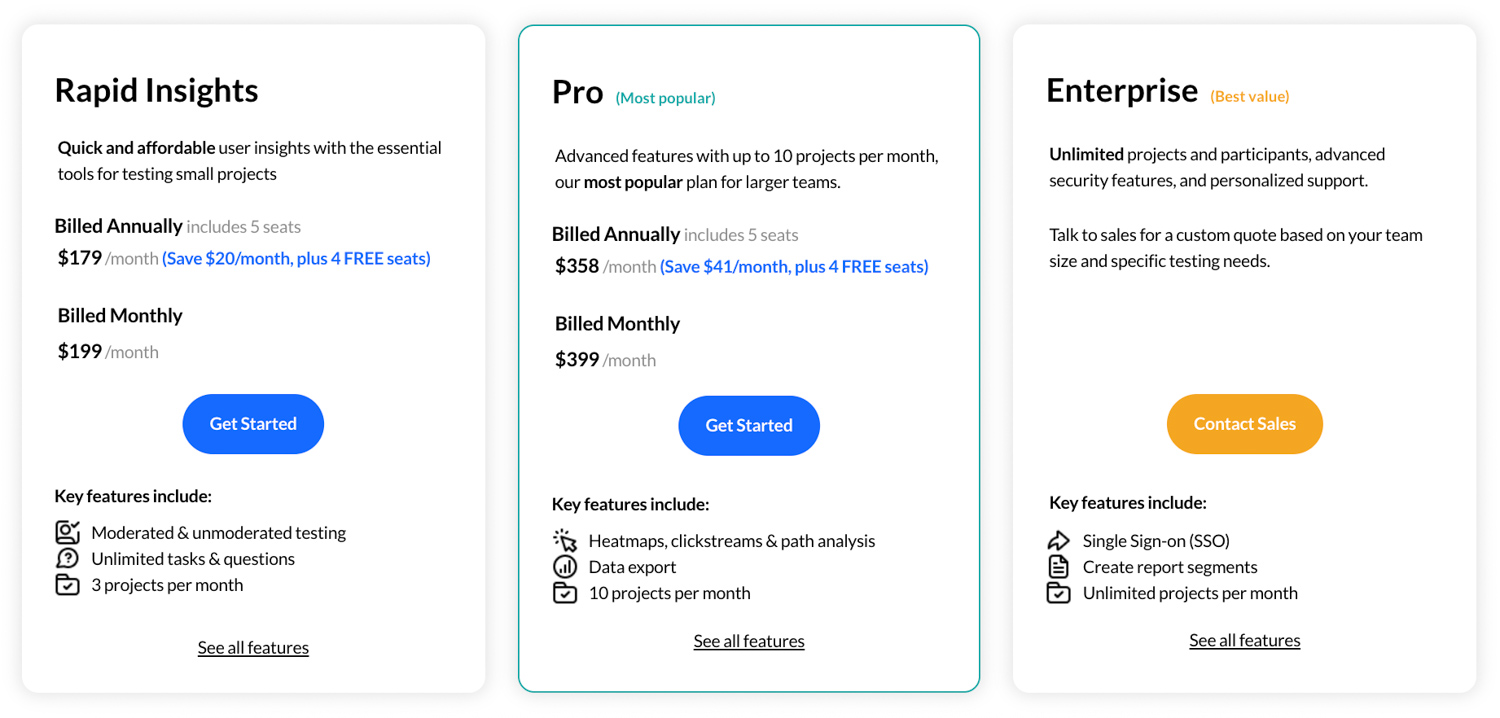
Source: Loop11
We’d recommend it to
Teams conducting structured usability testing on live digital products, particularly those needing detailed performance metrics and multilingual capabilities.
Comparison table: Feature-by-feature breakdown
| Tool | Moderated | Unmoderated | Card Sorting | Diary Studies | Session Replays | AI Analysis | Best For |
| PlaybookUX | ✅ | ✅ | ✅ | ✅ | ✅ | ✅ | Enterprise UX teams |
| dScout | ✅ | ✅ | ❌ | ✅ | ❌ | ❌ | Mobile diary research |
| Userlytics | ✅ | ✅ | ✅ | ❌ | ❌ | ❌ | Custom logic & global reach |
| UserZoom | ✅ | ✅ | ✅ | ✅ | ❌ | ✅ | Large enterprise orgs (sunsetting) |
| Maze | ❌ | ✅ | ❌ | ❌ | ❌ | ❌ | Design-stage validation |
| UXtweak | ✅ | ✅ | ✅ | ❌ | ❌ | ❌ | Structured UX testing on a budget |
| Trymata | ✅ | ✅ | ❌ | ❌ | ❌ | ❌ | Basic usability studies |
| Lyssna | ❌ | ✅ | ❌ | ❌ | ❌ | ❌ | Quick design feedback |
| Loop11 | ❌ | ✅ | ❌ | ❌ | ❌ | ❌ | Live site usability testing |
What to consider before looking for a UserTesting alternative
Switching research platforms isn’t just about swapping tools — it’s about making sure the next one fits how your team actually works. Here’s what to weigh before making a decision.
Research methods supported
The right tool should let you cover multiple types of studies, not just one. Look for platforms that support both moderated and unmoderated testing, as well as methods like card sorting, tree testing, surveys, and diary studies. That kind of flexibility matters when your research needs shift from discovery interviews to usability validation.
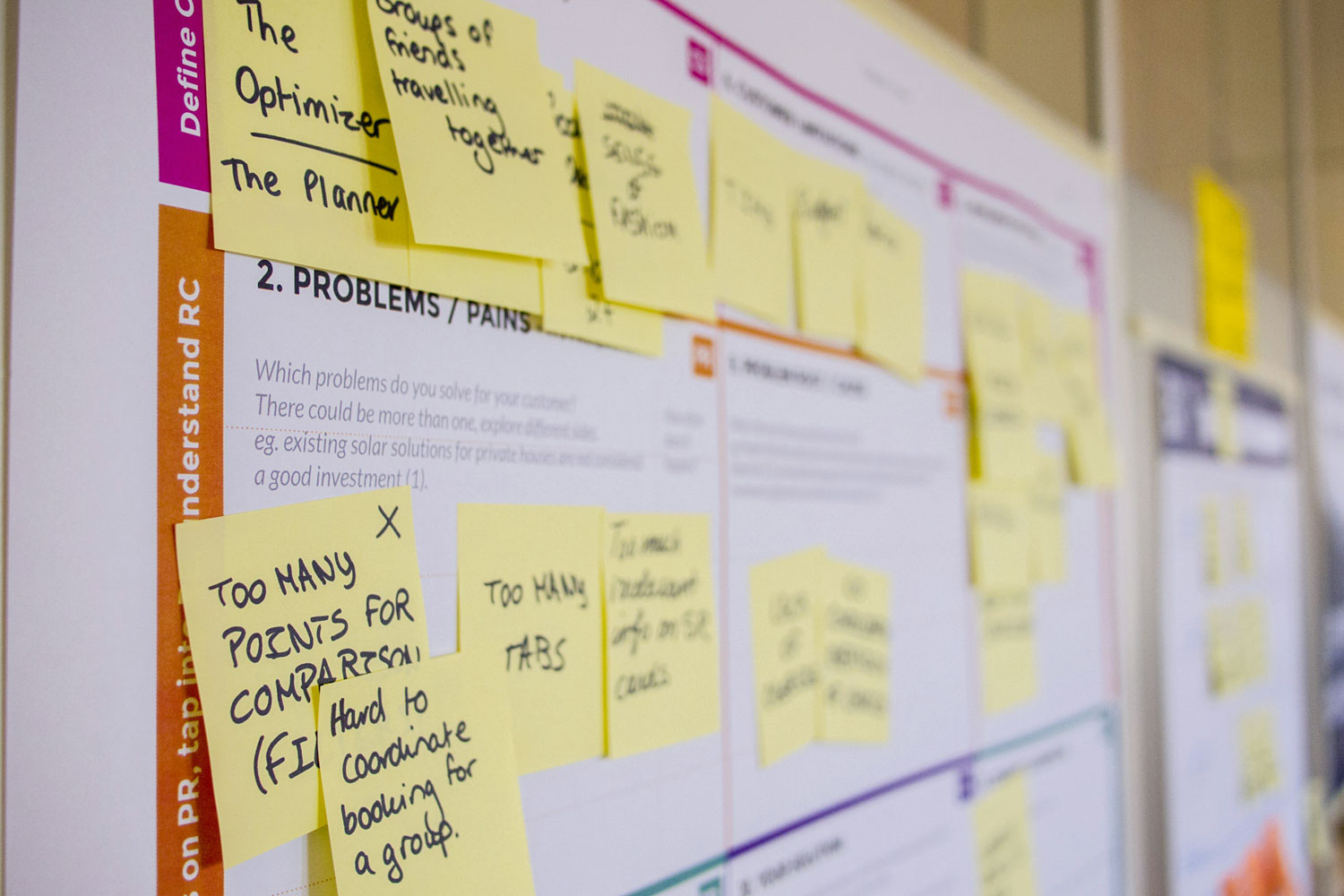
Source: Unsplash
Tools that specialize too narrowly often require stacking multiple platforms to cover your bases, adding unnecessary cost and friction to your process.
Participant recruitment options
Some tools come with built-in access to global tester panels, while others expect you to bring your own. You’ll want the option to do both. The best platforms offer demographic filters, screener questions, and niche targeting, so you’re not wasting time with the wrong participants.
For enterprise teams, data quality, fraud prevention, and panel verification are equally important, especially when research informs high-stakes decisions.
UX of the tool itself
Ironically, some research tools aren’t all that usable. A clunky interface or slow setup can drag down your workflow, especially in fast-moving product teams. Look for platforms with modern UIs, intuitive study builders, and collaboration-friendly features.
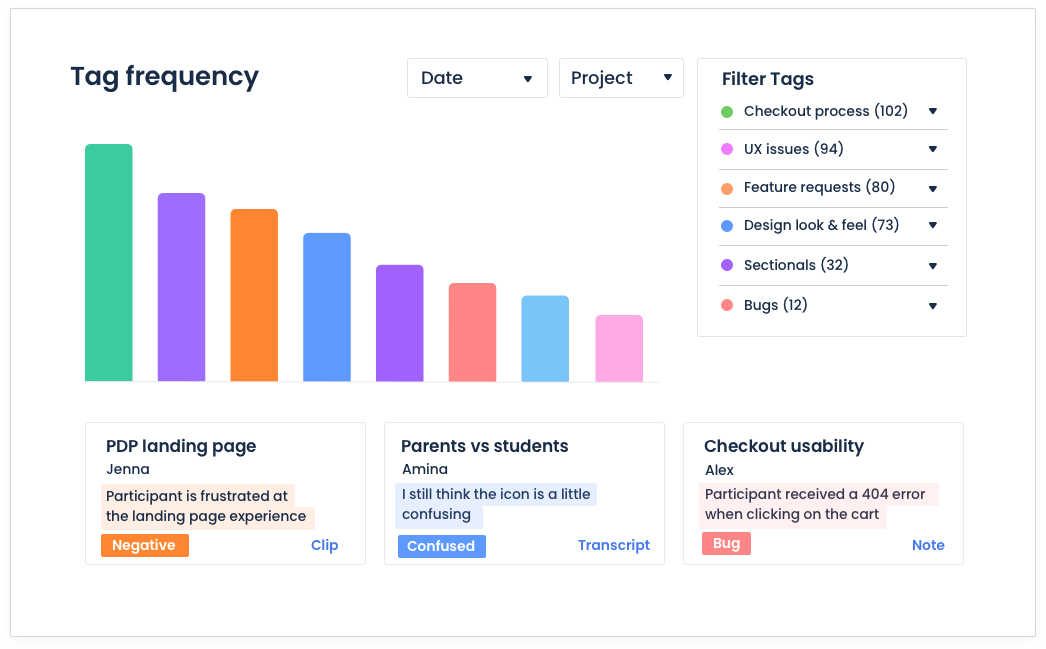
Source: PlaybookUX
If it takes longer to launch the test than to run it, that’s a problem.
Reporting, analysis, and insight sharing
Running the study is only half the job — getting insights out of it is where the real value lies. Prioritize tools that offer session recordings, highlight reels, tagging systems, and team commenting.
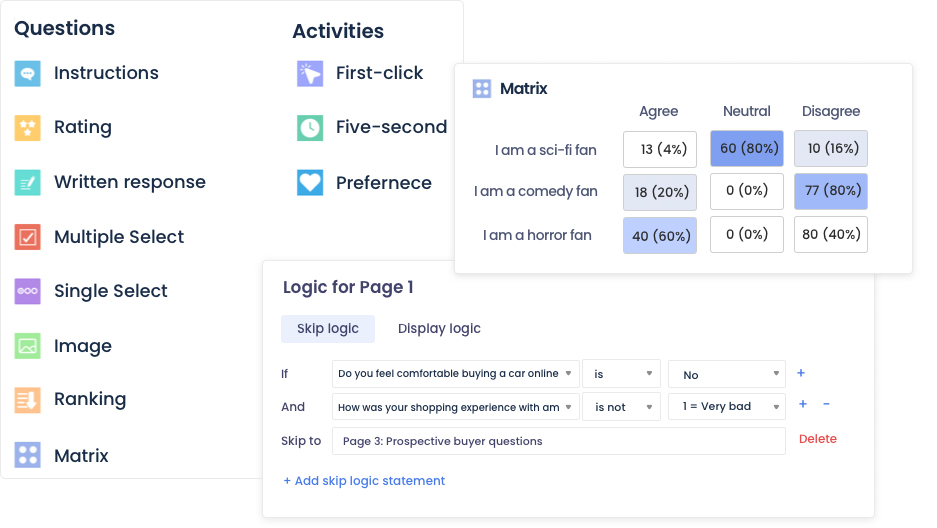
Source: PlaybookUX
Scalability and pricing
If you’re scaling research across departments or geographies, your platform needs to keep up. Tools that only offer seat-based pricing or lack role management can become bottlenecks.
On the flip side, tools designed for enterprise use often include centralized controls, security features, and dedicated support, making them more sustainable long-term. Pay-as-you-go models might look appealing at first, but can become unpredictable as you grow.
How to make the best choice based on your needs
Not every team needs the same level of depth, speed, or scalability. Here’s how to align your choice with the way your team works:
- Solo UX researchers at startups – Look for cost-effective tools with flexible plans and easy setup, especially those with BYO participants and a generous free tier.
- Product teams running lean experiments – Prioritize speed, async workflows, and lightweight tools that integrate with your design stack (e.g., Figma, Slack).
- Enterprise researchers needing advanced data and compliance – Choose platforms like PlaybookUX that support multiple study types, role-based access, SOC2 compliance, and scalable panel management.
- Design teams testing prototypes weekly – Seek tools with direct design tool integrations, fast unmoderated testing, and visual analytics like heatmaps and click paths.
- Marketers doing copy or concept testing – Go for tools that offer first-click tests, preference testing, and access to panels for rapid response.
Make sure your choice matches not just your budget, but also your timeline, collaboration style, and research maturity.
Final thoughts: Don’t just replace UserTesting — upgrade your workflow
If you’re thinking about leaving UserTesting, don’t just settle for a lookalike. Take the opportunity to find a platform that actually fits how your team works — something that supports the way you plan, test, and share insights across functions.
Whether you need more control over participant sourcing, more flexibility in study formats, or a better way to manage research at scale, it’s worth exploring your options. PlaybookUX gives you all of that in one platform — and you can book a demo whenever you’re ready.
FAQs
What is better than UserTesting?
It depends on your workflow. If you need more control over study formats, participant sourcing, or team collaboration, there are several tools, e.g., PlaybookUX, that may be a better fit depending on your goals.
What is the difference between Maze and Lyssna?
Maze is geared toward prototype testing and integrates with design tools like Figma, while Lyssna focuses on preference testing, first-click feedback, and simple surveys. Both are useful for early-stage input but differ in methods and depth.
How do I choose the right UserTesting alternative?
Start by listing the types of research your team runs (e.g., moderated, unmoderated, surveys, diary studies). Then assess which platforms support those methods, fit your budget, and offer the collaboration and analysis tools your team needs.
Which platform is best for enterprise UX research?
Tools like PlaybookUX and UserZoom are designed with enterprise needs in mind, offering advanced compliance, team management, and flexible study options across multiple departments.


